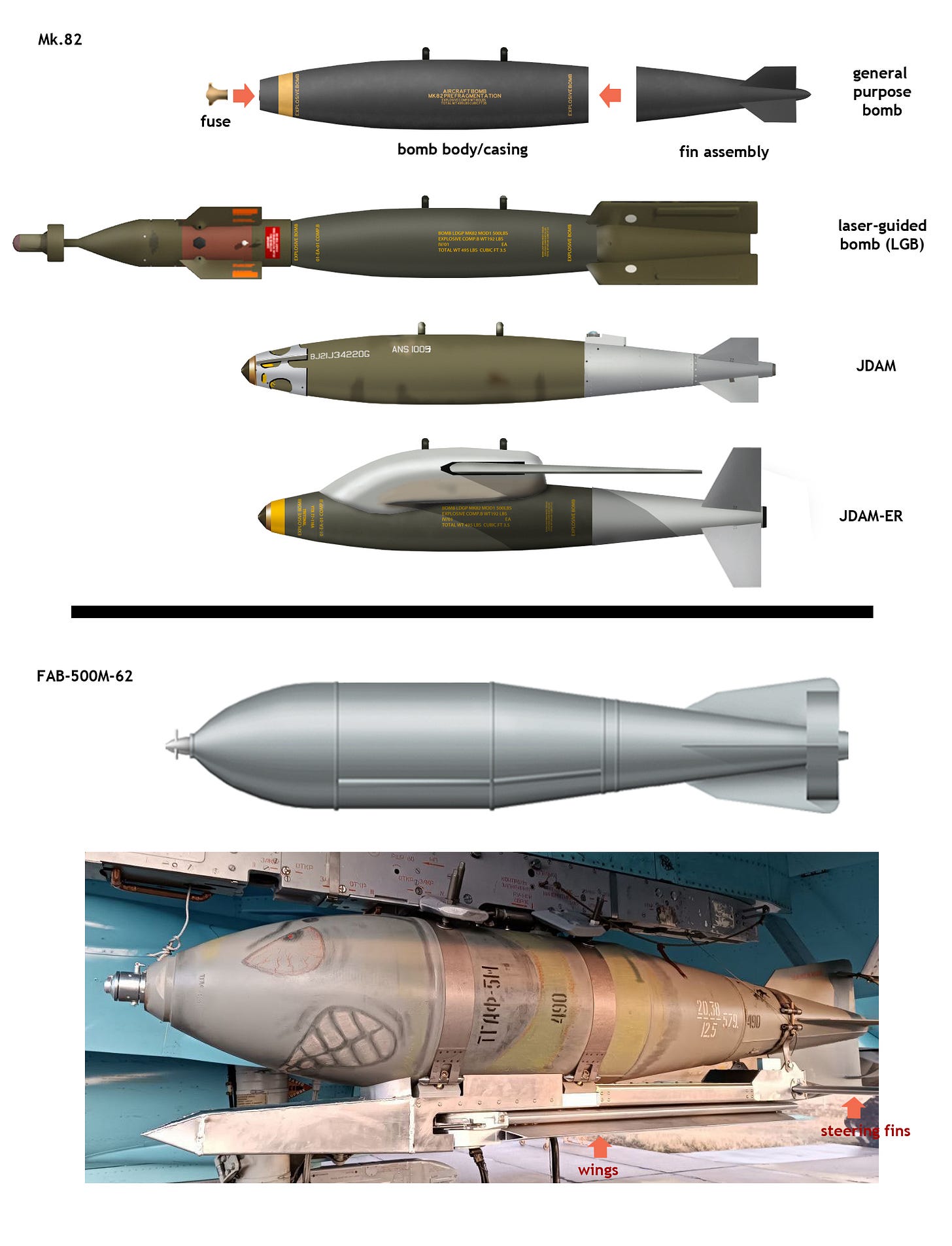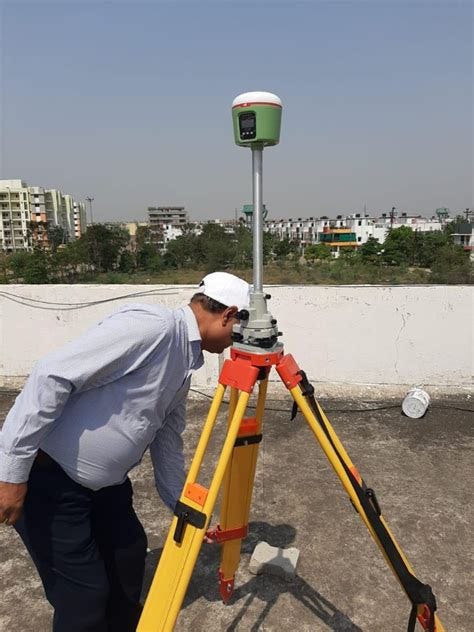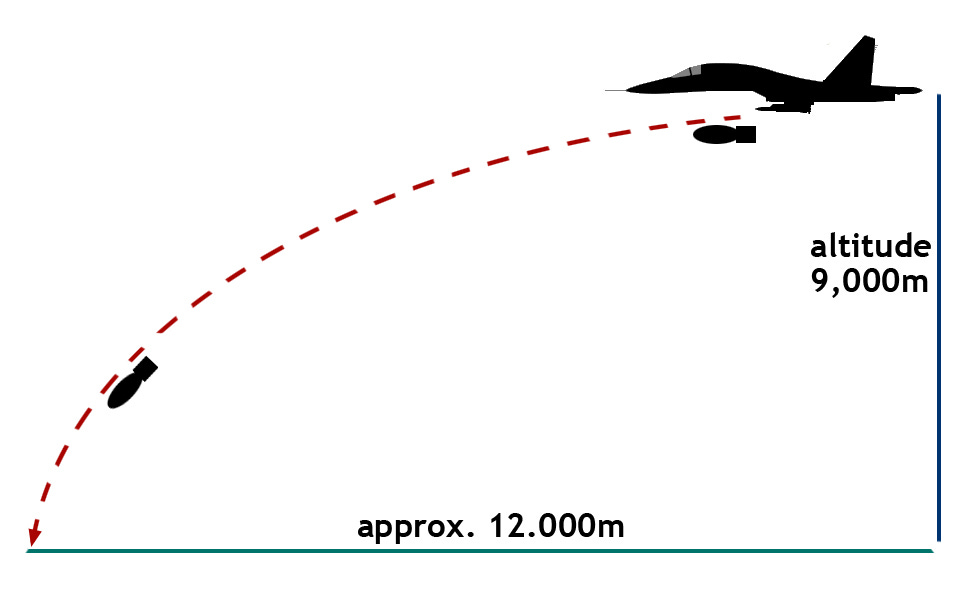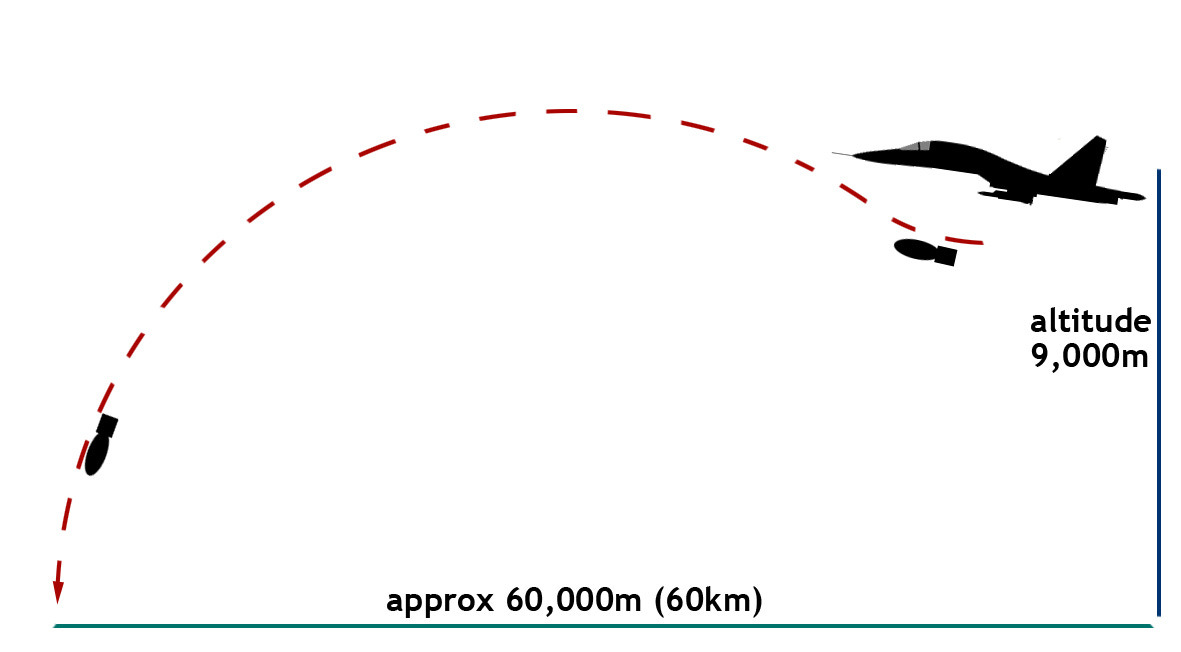So far, I have explained different ‘basics’ of modern-day air warfare: the ‘bare bottom’, the ‘very essence’ of how are integrated air defence systems and surface-to-air missiles operated nowadays – at strategic and at operational levels. Pending discussion of tactical level it is necessary to ‘do a step back’, sort of, and discuss the weaponry involved. This is explaining why is the VKS operating its fighter-bombers the way it operates them nowadays, and why is the PSU operating its ground based air defences along the frontlines the way it does.
***
As discussed to quite some length in the book Moscow’s Game of Poker, In Syria of the period 2015-2020, the Russian Aerospace Force (VKS) was flying the mass of bombing attacks by its fighter-bombers ‘like on a targeting range during a peace-time exercise’. It primarily targeted pre-selected, fix targets, geographic coordinates of which were entered into the navigation-attack (nav/attack) system of aircraft before the flight. Once airborne, VKS aircraft were underway at mundane speeds of around 600-800km/h, at an altitude of 5,000-6,000 metres. While Pudding’s PRBS-machinery was superimposing ‘advanced’, ‘satellite-guided’ and other types of ‘precision’ ammunition, actually, about 99% of bombs they’ve dropped were ‘free-fall’, ‘general purpose’ or cluster bomb units (CBUs): what is also known as ‘dumb bombs’ in the West. No more was necessary, because the forces targeted by the Russians had no means to oppose air power operating at such altitudes: at most, Syrian insurgents have got, time and again, small batches of old Chinese-made man-portable air defence systems (MANPADS). Many of these were disused, with poor batteries, and frequently missing even helicopters overflying the teams firing them at mere 100 metres altitude.

Make no mistakes: the Keystone Cops in Moscow bombastically declared every single bomb dropped over Syria for a 100% precise hit (that’s what earned them the nick Keystone Cops in Moscow). Officially at least, this was ‘possible’ thanks to the installation of the ‘highly advanced’ SVP-24 navigation-targeting (nav/attack) system into fighter-bombers of the VKS. This was advertised as so heavenly precise, that it made precision guided ammunition (PGM) unnecessary. Like if a weapon dropped from 5,000-6,000 metres altitude would need no correction of its route while coming down, for example because of the wind (especially not in a country as windy as Syria) etc.
Of course, all of this was nonsense, believed only by people who have no clue about - or are intentionally ignoring - physical laws and meteorology. The SVP-24 was nothing that Western aircraft haven’t had already since the late 1960s. Foremost: not only that the mass of bombs dropped by the Russians was missing its targets, but even the SVP-24 proved incredibly unprecise.
The reason was that the SVP-24 is depending on support from the GLONASS satellite navigation system, and as of 2015 this was in a p…. poor state. De-facto falling apart. It took the Russians quite some work….something like two or three years…. to….well, ‘repair it to an acceptable condition’, which is why the GPS is still in widespread use all over the Russian Federation. And even if: over 50% of combat sorties flown by the VKS over Syria in period 2015-2018 – i.e. at the times the Russians flew the mass of their air strikes over that country – was undertaken by old Sukhoi Su-24Ms, which never got the SVP-24 (nor any other, similar modifications).
Even so, the GLONASS remained too poor for military use. Over Syria, it was next to useless. Which is why the mass of Russian bombs dropped through the period October 2015 - February-March 2016 missed its targets by 100-150 metres. The solution was two-fold:
A) firstly, the VKS was flying, literally, thousands of bombing sorties, dropping – literally – shiploads of bombs. If they’ve dropped enough of these, sooner or later, one or another bomb actually hit the target. (Illustrative for this, by August 2018, the Keystone Cops reported no less than 39,000 sorties flown by the VKS: certainly enough, they claimed the destruction of 121,466 targets, too…).
B) The second solution was to install a large number – literally_ dozens – of so-called differential GLONASS-stations along the battlefield. Differential stations are nothing special, and in widespread use in the GPS-system whenever precision is necessary. For example: near all the (civilian) airports. They’re receiving and ‘cleaning’ (or correcting) the satellite navigation signal, making it precise to ‘less than 1 metre’. Their availability at least increased the precision of bomb-releases by fighter-bombers equipped with the SVP-24 or similar nav/attack systems (like Su-34s): once enough of these were installed around the battlefield, Russian bombs were missing their targets by 30 to 50 metres on average.
In Ukraine, well…firstly, the PSU was at least reasonably well-armed with all sorts of air defence systems already as of 2014, but especially as of February-March 2022 - as obvious from heavy Russian losses (some 40+ aircraft and helicopters shot down by the end of March 2022). Moreover, the Russians couldn’t go around the country and ask Ukrainians to be so kind to let them install differential GLONASS stations so their bombing would be more precise…
And so, in early March 2022, the VKS sent its Sukhoi Su-34s to bomb targets behind the Ukrainian frontlines from low altitudes with free fall bombs. In a matter of days, Ukrainian air defences shot down several of these, usually by Osa-AKMs (SA-8), but sometimes by MANPADs, too. Unsurprisingly, the practice was rapidly abandoned. Despite the holy SVP-24, the VKS needed a PGM, and then one with the range that would keep its fighter-bombers outside the range of Ukrainian ground-based air defence systems….
Long story short: almost a year later, the VKS has got several such weapons. Most widely used became two the essence of which is conversion of dumb bombs into guided glide bombs. Here it’s important to keep in mind few basic details about the two most important types of Soviet/Russian free-fall bombs.
During the Second World War, the USA launched the production of the M117 high explosive/general purpose bomb. This introduced a modular design, where the bomb body (or ‘casing’) was manufactured separately from the fin assembly and other major parts. The weapon had to be ‘put together’, or assembled, from pre-fabricated parts before it could be deployed in combat.
Again: long story short. Eventually, the design of the M117 was ‘perfectionalised’ in form of the Mk.80-series of bombs. There are four classic types and calibres of these, in production until this very day:
- Mk.81 = 250lbs (113kg)
- Mk.82 = 500lbs (250kg)
- Mk.83 = 1000lbs (454kg)
- Mk.84 = 2000lbs (907kg)
Regardless the calibre, the design has always the same aerodynamic shape. Principal part is the ‘body’ or ‘casing’: this is usually made of steel so to survive installation and deployment form aircraft underway at high speeds. More recently, there are variants made of other materials used for specialised variants of such weapons. One way or the other, the casing is then filled with explosive. In addition to explosive, it can also be filled with ball bearings. Alternatively, the casing can be ‘pre-fragmented’ along its inner sides, so that on detonation it’s fragmenting into shrapnel of selected form and size.
At the front of the casing, there is the opening for the primary fuse; at the rear for the secondary. The ‘nice’ thing about the Mk.80 series is its modular construction, though: the rear section, including fins, is separate and first must be attached to the bomb-body/casing. Over the time, the Mk.80-series and its modular design became something like ‘prototype’ for the mass of Western-designed bombs, be these of Argentinean, Belgian, Chilean, Chinese, French, Iranian, South Africa, or whatever other design: they might be slightly different in shape, but their modular composition is all the same like that of the Mk.80-series. That’s why plenty of parts are interchangeable, too. This modular design enabled the Mk.80-series to form the basis for the mass of US- and foreign-made guided bombs, too: ranging from the ‘mother of all the PGMs’ – the laser-guided GBU-1 BOLT, of the late 1960s – all the way to the modern-day, GPS-guided GBU-54 and similar stuff.
The Soviets had no time nor money for such finesse. For their air force, they needed ‘millions’ of cheap free fall bombs. Correspondingly, even their ‘most recent’ air-released bombs, the M62-series, were made in one piece – including a fin assembly already welded to the bomb’s body. If they needed any other kind but ‘general purpose/high explosive’ bomb, they would develop and manufacture an entirely new weapon. As a consequence, designations like, for example, BETAB-500ShP, OFAB-500ShN, FAB-500M-62, FAB-500T etc. might sound similar; they were all ‘free-fall, dumb bombs’, and their calibre is the same (500kg). However, their design, their purpose, and even their manufacturers were entirely different…
Because the fin assembly was welded to the weapon, converting such a weapon into a PGM was a major problem. The manufacturing quality of that fin assembly was often poor, and if there was just a little dent in it, the weapon would be flying in all possible directions, just not where aimed. Therefore, production of Soviet PGMs – like KAB-500L, KAB-500T, KAB-1500 etc… - had to use entirely new bomb casings, which wasn’t particularly cheap. Moreover, when the PGMs became widespread, in the 1990s…. well, the West was not really keen on adapting guidance kits to Soviet-made bomb-designs, and Moscow had no money for ‘such toys’. Result: over the last 20 years, Russia manufactured only few dozens of PGMs.

….and so it took some time until first guidance- and wing kits for FAB-250M-62 and FAB-500M-62 became available - and then outside Russia. Ironically, even then, the Keystone Cops in Moscow were still not particularly interested, and thus one of first manufacturers of such guidance kits became North Korea. This has copied the Russian designs and manufactured them at home. It was in that way that, Sudan, for example – and as readers of Hot Skies over Yemen, Volume 2 know for years already – began deploying FAB-250M-62s equipped with something like ‘North Korean-made MPK kits’, and that over Yemen in late 2015…
To make sure, at least in the Soviet Union/Russia, the idea of ‘glide bombs’ was not that old: it was just pursued in different fashion. Instead of bombs that could glide over long ranges, the Soviets developed aircraft that could fly high and fast enough to ‘lob’ them over long ranges.
Back in the 1970s, during the times of the (First) Cold War, the Soviet Air Force developed the MiG-25RB reconnaissance-bomber. This was equipped with the Peleng nav/attack suite, and equipped with installations necessary for deployment of tactical nuclear bombs. The idea was that a MiG-25RB, underway at around 21,000-22,000 metres altitude and the speed of around Mach 2.2., would release the bomb while still well outside the range of – your guess – US-made MIM-23 HAWK SAM.
Alternatively, MiG-25RB could be armed with a special version of the FAB-500M-62 general purpose bomb (filled with high explosive), designated the FAB-500T: this was coated in insulation, to lessen effects of operations at extremely high speeds (see: air friction). As should be known by now, MiG-25RBs and FAB-500Ts were deployed in combat by the Iraqis during their war with Iran, and proved an ‘almost perfect weapon’: they would enter the Iranian airspace flying low between mountains, to avoid detection. Then, some 100-150km into the enemy airspace, they would start climbing and accelerating to 21,000m (or more) and speed of Mach 2.2. The Iranian air force thus had very little time to react: indeed, if an F-14 was not in an almost ideal position – directly ahead and very high – in front of the MiG-25, it had next to no chances of an effective intercept. Closer to the target zone, the Iraqis were usually releasing their bombs from about 40-43km away from the target, thus always remaining safely outside the range of Iranian MIM-23B I-HAWKs.
Ideal solution, isn’t it?
Well, the VKS of 2022 had no MiG-25RBs in service any more, and needed better precision. Thus, the solution was quite logical. To make sure: I have no precise details ‘who’ nor ‘how’, but sometimes since March 2022, it was probably somebody at least related to the 929nd State Flight Test Centre V. P. Chkalov at Akhtubinsk AB that came up with a solution. I guess, testing has shown that a 500kg free-fall bomb released from a Su-34 from an altitude of around 9,000m and a speed of 900-1,000km/h could reach a target around 12,000 metres (12km) away from the point of release.
….now add small wings to that bomb, release it from a shallow climb - see: ‘lob’ it - and it might go as far as 60,000 metres – or 60km:
Precision is not ‘fantastic’: on average, and if the fin assembly of the FAB-250M-62 or FAB-500M-62 in question is a ‘reasonably good condition’ (see: no major dents), the add-on-fin-assembly is going to be sufficient to bring the bomb to within 100 metres from the aiming point. Be sure: you don’t want a 500kg bomb to go off 100 metres away from you….
….and if one then adds a relatively simple stabilisation mechanism, the bomb could become as precise as 30-50m. Enough to target enemy command nodes, forward storage depots, even bridges within some 50-100km of the frontline - and that outside the average engagement envelope of the mass of SAMs operated by Ukraine:
That’s the essence of the concept for what became known as the MPK (glide-bomb kit for bombs calibre 250kg) and UMPK (glide-bomb kit for bombs calibre 500kg).
(to be continued….)









Thank you again. Еverything is clear and understandable. Easily understood language. Looking forward to continuing.
I like how all the parts are falling together. Keep them coming. Thank you for all your work.